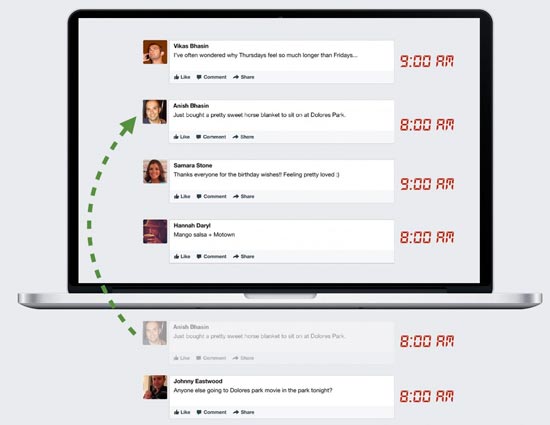Facebook’s News Feed algorithm is a living, breathing organism. It’s constantly changing, and Facebook noted in a media session Tuesday that the company wants to get better about informing users about changes. Facebook announced a couple small changes to the way that the site decides order in News Feed: Story Bumping, which allows engaging posts you haven’t seen to be bumped up to the top of News Feed later in the day, and Last Actor, which takes into account the last 50 engagements a user has performed, and gives those users a slight bump up in News Feed ranking.
Story Bumping
Say a friend, but not a close friend, had an awesome post at 8 a.m., but it didn’t show up on your News Feed when you checked at that time, because it was too far down. With Story Bumping, Facebook is borrowing from NBC with the idea of, “If you haven’t seen it, it’s new to you!” That post you missed from a friend at 8 a.m. is eligible to be bumped back up toward the top of your News Feed when you check again an hour or two later.
This gives a second chance for posts from users and pages who didn’t have their content shown shortly after posting.
Lars Backstrom, Facebook’s Engineering Manager for News Feed Ranking, discussed Story Bumping with reporters:
What can we do to make it so people aren’t missing these important stories? Maybe the position 1 and position 2 stories were a little bit better, but that story that was just below the fold, we really would’ve preferred to see that rather than (another story) … which just happened to be the newest thing. So we had this idea, “Let’s change the model slightly.” Before, I said, whenever you come to feed, we’re going to take all the stories that are new since your last visit and put those at the top. Let’s just tweak that a little bit, and instead of taking all the new stories, we’ll take all the stories that are new to you.
Facebook has already tested this among 7,000 daily active users in July. With Story Bumping in place for these users, there was a five percent increase in stories seen from friends, an 8 percent increase in stories seen from pages, and a jump from 57 to 70 percent in overall stories read. Facebook also tested the Story Bumping change with 80 percent of its own employees, and Backstrom said that there was only one complaint. Right now, Story Bumping is in effect for roughly 99 percent of desktop News Feed users, but the team is still tweaking it on mobile.
Last Actor
Another change Facebook announced Tuesday is Last Actor, which takes into account the last 50 interactions a user has done, such as liking a page’s post or writing on a friend’s timeline. This information is wrapped into the News Feed ranking system, so people with whom you’ve engaged most recently will be given more weight. For instance, if you’ve been liking and commenting statuses from your new coworker or best friend (or sharing posts from your favorite restaurant’s Facebook page), Facebook will push those posts up higher in News Feed.
When Last Actor was tested among Facebook employees as well as select users, Backstrom noted that there was a bit of a bump in engagement and positive reaction, but more modest than Story Bumping:
This change was less impactful than (Story Bumping), but still a nice change for feed relevance. So how does this work? Essentially what we wanted to do was try and capture your current state of mind as you’re consuming News Feed and using Facebook. A lot of the important symbols that we have in feed ranking are kind of long-term things: what’s my relationship to my friends and that kind of thing. We wanted to make this more real time, “What am I consuming right now?” So we built this new signal where we take into account the most recent interactions that they’ve had.
Facebook also tested something it called Chronological By Actor, where there’s more chronologically-ordered posts from people users have engaged with most recently, but Backstrom said that this led to less engagement from users in tests, so Facebook is still playing with this.
Backstrom noted what many users have been saying, that people still want to see things in chronological order. However, Chris Cox, Facebook’s Vice President of Product said that there’s a vital difference in operation between Facebook and Twitter.
Better Information
Want to know more about what Facebook changes and when? The company promised Tuesday that it will post more blog posts on the Facebook for Business site about updates to News Feed.
Here’s an excerpt from the first such post:
The goal of News Feed is to deliver the right content to the right people at the right time so they don’t miss the stories that are important to them. Ideally, we want News Feed to show all the posts people want to see in the order they want to read them.
This is no small technical feat: every time someone visits News Feed there are on average 1,500 potential stories from friends, people they follow and Pages for them to see, and most people don’t have enough time to see them all. These stories include everything from wedding photos posted by a best friend, to an acquaintance checking in to a restaurant.
With so many stories, there is a good chance people would miss something they wanted to see if we displayed a continuous, unranked stream of information. Our ranking isn’t perfect, but in our tests, when we stop ranking and instead show posts in chronological order, the number of stories people read and the likes and comments they make decrease.




0 Comments
You can be the first one to leave a comment.